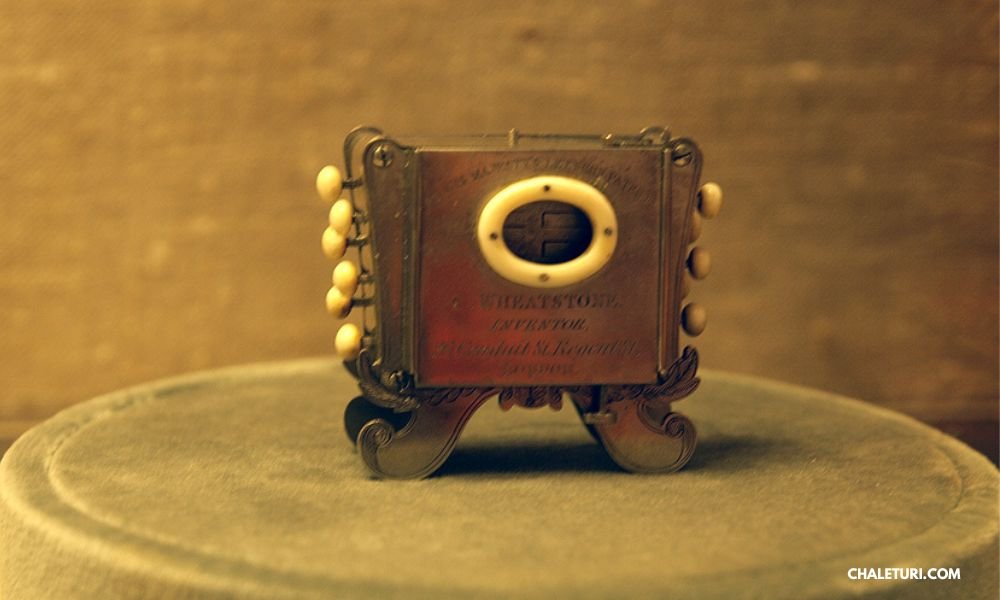The mysterious Symphonium Out of all the neglected and mysteriously cases of such things as the currently hard to imagine research, the Symphonium comes close to fascination. Out of those who possess some knowledge of such matters, the Symphonium has been a good historical sign. In the late nineteenth century, the Symphonium’s sweet and soothing tones earned it much popularity among the people. Now, its encumbered aspects concerning the wrecked the symphonium files still alive tend to kindle the interest once again. Are those files actually missing, or have the myths of the music contained in those files yet to be discovered?
What is the Symphonium?
The Symphonium is a perfectly exquisite musical history. Most accurately, it can be described as a mouth organ, however, it is like no other which pleases many musicians and collectors. The symphonium differs from the mouth organ in the production of sounds which in the mouth organ depends on the use of a lot of reeds. It incorporates a series of disks with holes in them. The discs oscillate within the device thus creating its distinctive heavenly like sounds.
Such a construction of the Symphonium permitted a high level of accuracy and clean sound which was not achievable at the time. This led to its widespread popularity for people looking for a more enjoyable musical experience. The creation of great and intricate tunes without the planner of extra instruments was a great leap forwards in those times.
Though the situation has changed and technology advanced the Symphonium gradually became forgotten. Its demise was further youthful by the emergence of other more advanced instruments which were manufactured at lower costs and are easy to handle. Yet, the Symphonium is undoubtedly the Artefact of the past times, and attempts to recover its missing files continue to interest the fans around the world.
Brief Historical Overview
Symphonium – one more-patented within the dreadful impatience of 19th century Provence, when technological progress stepped into the world of sounds. Symphonium, is dated back to 1829, and has been one of the first devices that attempted at presenting music without the need for individual audio performers, thus permitting the enjoyment of complicated musical works at home.
It ruled the markets for a while though. The sensation of having an effective symphony at home courtesy of the Symphonium’s invention also made an abundant audience in those days. However, the invention of the graphophone made it less and less used.
Maybe it has disappeared from the time of appreciation, but basically there was no ‘death’ of the Symphonium. The collector’s interest and history are only to the active phase of observation in this product, which connoisseurs are interested in, and its history. Today it is impossible to use any contemporary multimedia pieces of furniture without considering the relevance of this sundial in the context of creativity and technology. Will the air records have been retrieved out from some passenger plane and tucked away comfortably in the time vault?
The Mystery of Deleted Symphonium Files
Origins of the Deleted Files
In the digital age, the mystery of the deleted Symphonium files has emerged as a tantalising enigma. These files, which included many materials like recordings and compositions which do not live up to their normal’s reputation only become useful when these materials in those other forms are lost, were apparently buried in neglect and then buried in obsolescent technology.
The disappearance of the said files begat a new wave of hysteria. Were the missing files discreetly deleted in the process of migration to the new storage media or they have been rendered unusable by the inefficient storage media? In the case of texts belonging to the instruments under study and their anthropological clients, this death is even more catastrophic. It is akin to the loss of a whole chapter in the history of the instrument.
These deleted files are not simply files; they exemplify a transformative potential regarding the knowledge about the Symphonium’s history in the course of musical art. Many people have made this search, hoping this valuable cultural material can be preserved.
Why the Files Matter
There is more than harmful nostalgia behind the importance of the Symphonium files. The recording contains much information rich in historical and cultural significance. They give evidence of the musical style or fashion that once existed and how the artists and composers were trying to manipulate the Symphonium towards achieving higher artistic excellence.
With regard to other researchers, it may well be just a very useful source of information, giving a picture of the music that was loved and created in a period long gone the insights into music that these files could provide can reshape our conception of music history and impact the ways in which new music is researched and appreciated.
As has been explained, these are not just files, rather the symphonium files are instruments of hinge to history. A hinge connecting the present and the yesteryears of great adventures in music creation. Their retrieval is not a matter of mere technologies and skills but an urgent cultural task; for such a time would ensure that future generations understand how rich in depth humanity’s musical creation is.
Efforts to Recover Deleted Files
Current Recovery Projects
The search for the lost Symphonium files has created a worldwide participation of historians, technologists, and even music lovers. Many initiatives are in progress, without exception headed by people or organisations eager to restore such valuable treasures.
Such efforts could not have been possible without modern technologies. New modern file recovery techniques, such as advanced scanning and encryption, are used to find those files and recover them. There have also been initiatives for cooperative platforms and open-source projects that enable different people with different skills to contribute.
That many of such projects exist and are getting done, is worthy evidence of the legacy of the last symphonium. They are making it easier for a potentially diverse range of people passionate about this ancient instrument to come together and work towards its appreciation.
Challenges Faced in Recovery
There is a great deal of zeal and technological resources, but retrieving the deleted Symphonium files is easier said than done. You would run into technical complications because most of the old storage media are already irretrievably broken, making traditional recovery techniques ineffective.
Besides, other issues, such as legal and moral issues, make recovery even more challenging. The documents, possessed by companies long gone or private libraries, for example, are rarely easy to obtain, making it hard to retrieve and restore files.
There is also the ethical conundrum concerning the alteration of the files being worked on or updated when recovery is in progress. How to deal with such a situation, while emphasising on recovering the files, is rather complicated as restoring the files without affecting the present issue of the history of Symphonium is concerning.
Significance of Recovered Files
Contribution to Musicology
With such valuable materials in a scientist’s hand for the retrieval of the files associated with the Symphonium, such great hopes are alive for St. Petersburg. These files constitute a unique opportunity to be or to study the direction of music that has long ago been forgotten.
Studying the works and recordings collected in the files, the researchers will realise how modern music came into being. Symphonium, with its distinctive swing, while launching a variety of devices, is undoubtedly an interesting subject of study in the border region of arts and technologies.
In the end, the files that have been recovered may change one’s perception and grasp of the historical development of music, opening newer paths that may be taken by researchers and hobbyists of music history.
Cultural and Educational Importance
The recovered Symphonium files, in addition to their perceived academic importance, are of great cultural and learning value. They are important to history, enabling one to imagine a time when music was not just for pleasure but was also a ground for some advancement.
Through the holding of these files today and into the future, people will be able to understand and appreciate the place, and or role that the Symphonium provides, in the music and cultural arenas. The portfolios are moreover instructive in nature as they reveal how composers and musicians have grappled with various technological and aesthetic issues over time.
The publications and files recovered can be presented to the public and the scholarly communities for learning and trying to develop a more positive attitude towards the lightning, yet, variegated aspects of music. For and creation does respect the Symphonium, its spirit cannot quickly fade away from the society of musicians.
Conclusion
The current attempts to recover the deleted Symphonium files make one appreciate the specialness of this exceptional piece of equipment. Those files had been thought of as lost for so long, the time to find them and lavish a long overdue history lesson in music is now.
The efforts of dedicated people and modern equipment make it possible to dream about the return of these files. And while doing that, we cover not only the history of the Symphonium but also learn more about how society and music evolved.
It does not matter if you are a Symphonium lover, a history freak or a music lover; everyone is invited to join this hunt for the Symphonium files and travel into the past. In this active narrative, you become one of those whose purpose is the commemoration and maintenance of the amazing history of the Symphonium.
FAQs
What exactly happens to digital files when they are deleted?
Most deleted files can be restored unless they have already been overwritten. Just like other data on the storage medium put in them until others come to use the space that they occupy currently available.
Are there known cases of successful recovery of Symphonium files?
Although the number of such cases is definitely limited, development cycles of such activities in the future still will improve, giving positive recovery results from the effort of collecting pieces or parts of files that add up to the lost bits of files that are already known.
What are the risks involved in attempting to recover deleted files?
Such activities in most cases tend to be troubleshooting that most likely end up in data loss or data corruption, especially when such activities create new files instead of modifying the ones that are already there. The problem is legality, generally, and ethical concerns – possession, and authenticity in particular.
Where can I find my Symphonium backup files?
Symphonium backup files are self-evident and are stored in secure storage environments or cloud storage as is common in preservation projects.
European Lisp Symposium 2024 Recordings are now live?
Yes, it is true that the video captures of the European Lisp Symposium 2024 have been put up and can be accessed for use in class or research purposes.
Show folders in search view as an optional togglable filter Symposium?
Incorporating the option of displaying folders as one of the overlays in the search views helps in improving the ergonomics of the application.
Ability to download to visible storage in Symposium?
Mobile applications continue to be developed as new ways turn out to enable the possibility of downloads to the mobile storage outlook, thus improving usability.
[DEV] Symphonium: Music player & cast, the self-hosted?
Enabling self hosting of Symphonium music player and cast solutions allow for host-wider and cast control features.
[Dev] Symphonium 2.0 is out (Music player and cast)?
In this update, new features such as advanced music playback and playback thru casting together with enhanced existing features were introduced to the utenti.
Does Symphonium automatically upload my local files?
Current versions of Symphonium, the music player solutions, take account of users’ privacy and control by providing an option of user-selected file upload and storage.




